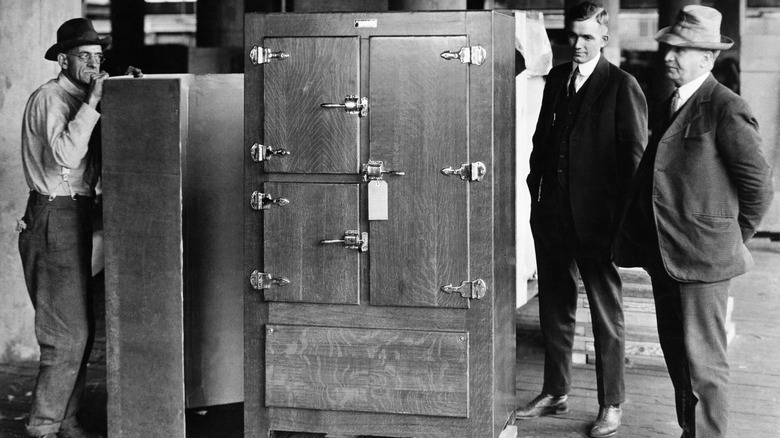The Vintage Version Of This Everyday Appliance Could've Killed You
Is your refrigerator running? If it is, you'd better start running too! This isn't true nowadays, but about 100 years ago, owning a fridge could be dangerous. To give a brief history of refrigeration, we've long stored food in crude ice pits, and eventually in iceboxes. In the 1800s, there were iceboxes which vaguely resembled modern fridges, but if the ice melted, your food spoiled. It was in 1913 that the first electric fridge was invented, which revolutionized food storage when it was mass-produced five years later. The only catch was that it might fill your house with lethal fumes.
At the time, these early fridges used an innovative method for generating cool temperatures: when powered on, they utilized toxic gases as refrigerants. Your average early 20th century fridge was likely to contain ammonia, methyl chloride, and sulfur dioxide running through its system. When it worked correctly, those deadly chemicals were kept separated from both the food and the fridge's owner. But, as you can guess, accidents happened. There were accounts of pressure valves leaking and compressors failing, leaking the chemicals into the kitchens of unsuspecting homeowners. If you survived, it was likely because a firefighter carried you to safety. Nowadays, you should expect your fridge to last about 12 years, but back then, you fridge could have outlived you.
The toxic world of early refrigerators
Not a whole lot of households contained electric fridges because they were outrageously expensive, but it quickly became wise to leave this groundbreaking technology in the backyard, instead of the kitchen. The ammonia fumes were notorious killers, although methyl chloride was also nasty stuff: it's now considered hazardous waste and even brief exposure can do serious damage to your nervous system, kidneys, and liver.
There were a few attempts to fix this problem, including an attempt by Albert Einstein in the 1920s to design a more stable fridge model. Einstein's model never took off, as the Great Depression and lead-up to World War II in the early 1930s (Einstein and his co-inventor, Leo Szilard, lived in Berlin, Germany, at the time) led to his abandoning the project. A fix — sort of — came about around the same time, when an inventor named Thomas Midgley invented a new coolant called Freon, which was less toxic and therefore less likely to poison your food.
Was there a catch? Absolutely. The chemicals in Freon came to be known as notorious greenhouse gases which helped damage the ozone layer in Earth's atmosphere. It wasn't until the dawn of the 21st century when the refrigerant was officially banned in the U.S. We're producing modern fridges with less dangerous chemicals — for both people and the Earth — but you should still avoid making your fridge work so hard, even if it's not lethal anymore.

